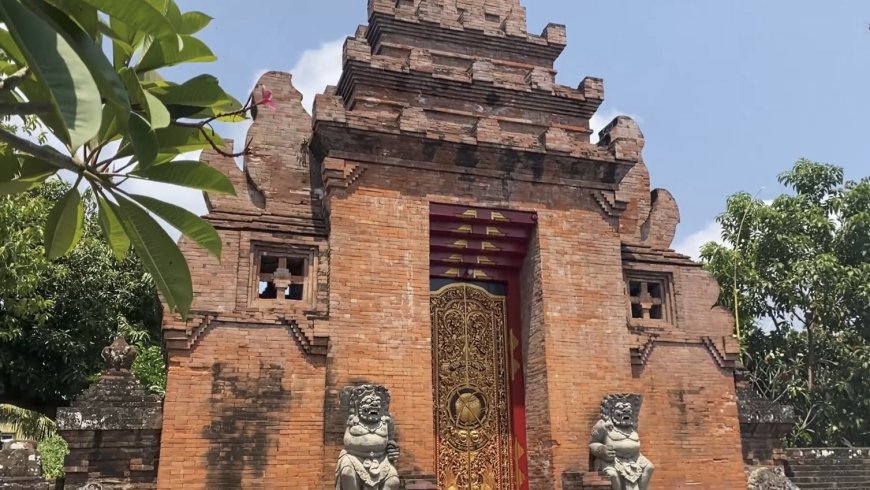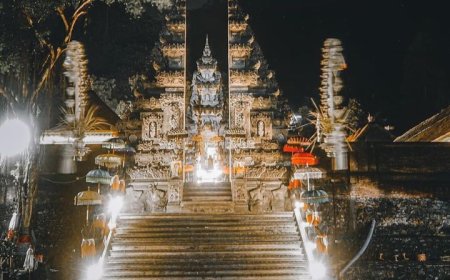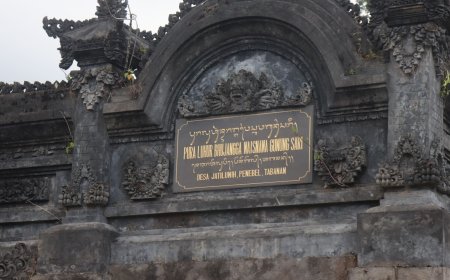The Majesty of Tambang Badung Temple, Ancestral Temple of the Puri Pemecutan Family
Pura is one of the cultural heritages of the Hindu community in Bali. Each temple has its own uniqueness, one of which is Tambang Badung Temple. Tambang Badung temple is one of the oldest temples in Bali and serves as the ancestral temple for a prominent royal family in Bali, namely the Puri Pemecutan Badung family.


Silent amidst the hustle and bustle of downtown Denpasar, Tambang Badung Temple stands as one of the oldest temples in Bali. The existence of Tambang Badung Temple dates back to the 14th century when Ida Bhatara Kyayi Jambe Pule became the king in the Badung region, which was then known as Gumi Badeng. He had descendants, including Kyayi Anglurah Ketut Pemedilan, who held the title Kyayi Macan Gading and laid the foundation for the Puri Pemecutan Badung.
Kyayi Macan Gading's descendant, Kyayi Anglurah Pemecutan, with the title Kyayi Anglurah Maharaja Sakti, became the third king of Pemecutan Badung. During his reign, Tambang Badung Temple was expanded and renovated, leaving a legacy that we witness today. Subsequently, the temple was adopted by Puri Pemecutan, creating a close connection between Tambang Badung Temple and the ancestral heritage of the Puri Pemecutan family.
 Temple Signboard (Photo Source: Personal Collection)
Temple Signboard (Photo Source: Personal Collection)
Tambang Badung Temple is located in Banjar Pemedilan Kerandan, Pemecutan Village, Denpasar. Precisely on Gunung Batukaru Street, west of Pasah Pemedilan Temple. This temple was originally named Pura Taman, then changed to Pura Ayu Panesteran Panembahan Badung, and finally became Tambang Badung Temple. Like most temples in Bali, this two-hectare temple is also divided into three mandalas, consisting of Nista Mandala, Madya Mandala, and Utama Mandala, with a higher concentration of shrines in the Utama Mandala.
 Gora and Gori (Photo Source: Personal Collection)
Gora and Gori (Photo Source: Personal Collection)
In the Nista Mandala section of the temple, located right in front of the market, there are two cannons named Gora and Gori adorning the candi bentar. This Nista Mandala area is typically used as a parking space when there is no major ceremony taking place. However, during significant ceremonies, it serves as a resting place or preparation area for the worshipers before entering the next area. This is because the Bale Wantilan in the Madya Mandala area is typically used for dance performances or traditional puppetry.
 Temple's Wantilan (Photo Source: Personal Collection)
Temple's Wantilan (Photo Source: Personal Collection)
Entering the Madya Mandala area, there is a Wantilan pavilion commonly used as a preparation space for ceremonial rituals. The Wantilan is typically utilized for performances such as dances or wayang shadow puppetry during major ceremonies. It also serves as a waiting area or a resting place for worshipers before entering the Madya Mandala area to participate in the prayer ceremony.
 Shrine of Shiva Entrance (Photo Source: Personal Collection)
Shrine of Shiva Entrance (Photo Source: Personal Collection)
Before stepping into the main mandala area, we are welcomed by two main gates, namely the Shrine of Shiva (Pemedalan Siwa), which houses two statue sculptures named Jakse and Jaksi, as well as the Kurung Temple commonly used by arriving worshippers (pemedek).
Inside, the main mandala is filled with several shrines. There are three main shrines in Tambang Badung Temple: the main shrine of the temple (pelinggih pokok pura), the shrine of the ancestral deity, and the shrine of Gedong. The main shrine, also known as "pelinggih luhur kaler" or "anglayang," is dedicated to Ida Bhatara Siwa on Mount Agung, Batur, and Mount Jati. This shrine takes the form of a padmasana with bedawang nala and dragons adorning its surroundings. Next is the shrine of the ancestral deity, known for its unique architectural structure resembling a temple with two lingga inside. Adjacent to the main shrine stands the sturdy "pelinggih gedong dalem Tambangan Badung," which serves as the abode of Siwa Dalem and Ratu Ngurah Ratu Agung Kiwa Tengen.
The main mandala also includes the grand pesanggrahan, consisting of various dedications to the Sad Kahyangan temples such as Sakenan, Uluwatu, Batukaru, Besakih, and Batur. Among these three shrines, there are, of course, several other shrines each serving its specific function. Some of them include the series of hyang ibu shrines, including Hyang Ibu Agung, Ibu Meranggi, Ibu Ngurah, Ibu Jembrana, Ibu Bongani, Ibu Rurung, Ibu Tameng, Ibu Pupuan, Ibu Bandem, Ibu Taruna, Ibu Tojan, Ibu Mekel Bukit, Ibu Klating, Ibu Tinggi, Ibu Janggal, Ibu Prani Gata, Ibu Pasek Agung, and Ibu Sari.
Tambang Badung Temple is also equipped with several complementary pavilions, such as Bale Semanggen, Bale Prasanak, Bale Penganten Genah Bhatara Manik Galih, Bale Gajah, Bale Pemiodan Peranda Sinuhun, Bale Ban, Bale Pererepan Ratu Ayu, Pewaregan, and Lumbung. On the north side of the temple, there is a Palebahan Pura serving as the shrine of Ratu Ayu Saren Taman, the abode of Ratu Ayu Mas Meketel, Ratu Mas Mereronce, Bhatari Gayatri, and Bhatari Gangga. Tambang Badung Temple has also been inventoried by the Bali Cultural Heritage Preservation Center in 2016. Therefore, as the younger generation of Hindus, it is essential to continue preserving this sacred place.






























































